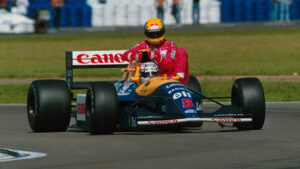Active Suspension
Active suspension is a technology used in Formula 1 racing that allows teams to adjust the suspension of their cars on the fly, during a race. This allows for greater stability, improved handling, and faster lap times.
The basic principle of active suspension is to use sensors and actuators to control the movement of the suspension. Sensors, such as accelerometers and ride height sensors, collect data about the car's movement and send it to a computer. The computer then uses this data to adjust the suspension, by activating the actuators (typically hydraulic or electrical). This allows the suspension to be adjusted to suit the specific conditions of the track, such as bumps or changes in surface grip.
Active suspension was first introduced in Formula 1 in the early 1990s. At that time, the technology was considered revolutionary, as it allowed teams to make real-time adjustments to the suspension during a race. This gave teams an advantage over their competitors, as they could make their cars more stable and consistent on different parts of the track.
One of the first teams to use active suspension was Williams, in 1992. Their car, the Williams-Renault FW14B, was equipped with an active suspension system that could adjust the ride height and stiffness of the car in real-time. The car was driven by Nigel Mansell and Riccardo Patrese, and it proved to be very successful, winning the Constructors' and Drivers' Championships that year.
Unfortunately, active suspension was banned from Formula 1 in 1994 due to concerns about cost and a perceived lack of relevance to road car technologies. Even though it was banned, the knowledge and understanding gained from the active suspension technology has been applied in other areas of vehicle dynamics control, it had a major impact on the development of semi-active and passive suspension systems.
The technology continued to be refined and used in other forms of motorsport, such as endurance racing and rally. It is also used in commercial vehicles such as buses and trucks, where it can improve ride comfort and handling.
In Formula 1, teams now rely on more sophisticated aerodynamics, tire management, and chassis set-up to gain an edge on the competition. While active suspension is no longer allowed, its legacy continues to influence the sport, as teams continue to look for new ways to improve the performance of their cars.












LAST 3 F1 Fan COMMENTS